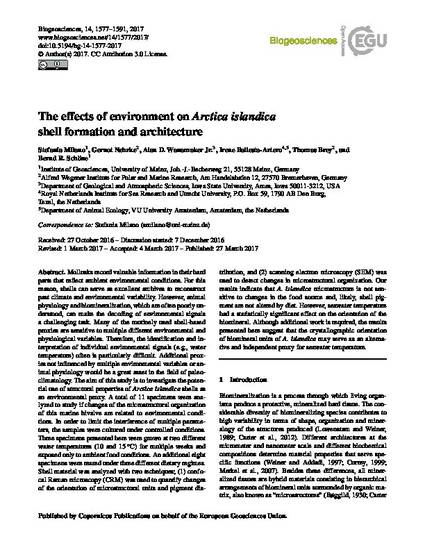
Mollusks record valuable information in their hard parts that reflect ambient environmental conditions. For this reason, shells can serve as excellent archives to reconstruct past climate and environmental variability. However, animal physiology and biomineralization, which are often poorly understood, can make the decoding of environmental signals a challenging task. Many of the routinely used shell-based proxies are sensitive to multiple different environmental and physiological variables. Therefore, the identification and interpretation of individual environmental signals (e.g., water temperature) often is particularly difficult. Additional proxies not influenced by multiple environmental variables or animal physiology would be a great asset in the field of paleoclimatology. The aim of this study is to investigate the potential use of structural properties of Arctica islandica shells as an environmental proxy. A total of 11 specimens were analyzed to study if changes of the microstructural organization of this marine bivalve are related to environmental conditions. In order to limit the interference of multiple parameters, the samples were cultured under controlled conditions. Three specimens presented here were grown at two different water temperatures (10 and 15 °C) for multiple weeks and exposed only to ambient food conditions. An additional eight specimens were reared under three different dietary regimes. Shell material was analyzed with two techniques; (1) confocal Raman microscopy (CRM) was used to quantify changes of the orientation of microstructural units and pigment distribution, and (2) scanning electron microscopy (SEM) was used to detect changes in microstructural organization. Our results indicate that A. islandica microstructure is not sensitive to changes in the food source and, likely, shell pigment are not altered by diet. However, seawater temperature had a statistically significant effect on the orientation of the biomineral. Although additional work is required, the results presented here suggest that the crystallographic orientation of biomineral units of A. islandica may serve as an alternative and independent proxy for seawater temperature.
Available at: http://works.bepress.com/alan-wanamaker/12/

This article is published as Milano, S., Nehrke, G., Wanamaker, A.D., Ballesta-Artero, I., Brey, T., and Schöne, B.R., (2017) The effects of environment on Arctica islandica shell formation and architecture. Biogeosciences, 14, 1577-1591. doi: 10.5194/bg-14-1577-2017. Posted with permission.